Original | Odaily Planet Daily ( @OdailyChina )
Author: Wenser ( @wenser 2010 )
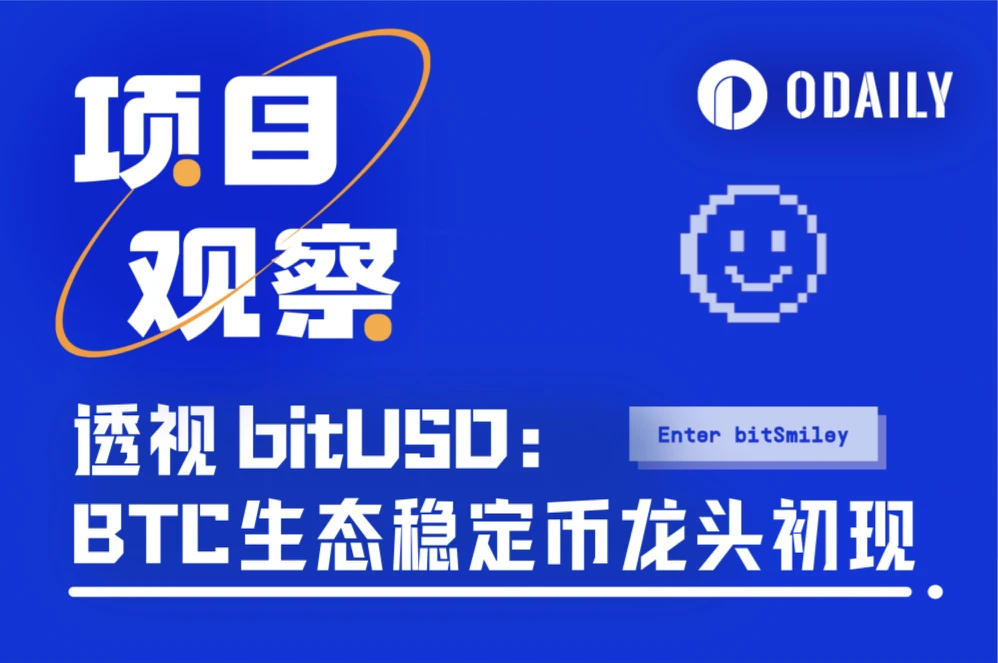
On October 28, the Bitcoin native stablecoin project bitSmiley announced the successful completion of a second round of financing of $10 million, with participation from several well-known investment institutions including MH Ventures and Skyland Ventures. This round of financing means that bitSmiley has achieved great first-mover advantages in terms of liquidity expansion and diversified scenario applications of Bitcoin decentralized applications. Combined with past project data, it has now established itself as the leading position of BTC over-collateralized stablecoins, and is expected to inject new vitality and vitality into the BTCFi track. On the other hand, the results of the US election are approaching. No matter who is elected in the end, based on the past speeches of Trump and Harris, the subsequent crypto-friendly environment has become inevitable. This move may further promote the development of the BTC ecosystem including BTCFi and the mainstreaming of cryptocurrencies. For ordinary market users who care about returns, the subsequent bitSmiley tokens will be listed on Bybit Launchpad and Gate Startup Prime. Based on past performance, the return of 10 times is worth looking forward to.
Meme fever is sweeping the crypto market. Can the BTC ecosystem take advantage of this trend and drive the arrival of a new round of bull market cycle? Odaily Planet Daily will analyze this article using bitSmiley as the entry point for readers reference.
BTCFi - One of the hottest bull market narratives as BTC reaches new highs
As the situation in the Middle East has eased to a certain extent in the short term, combined with the view of many industry insiders in the crypto market that Trumps election as the US president in 2024 will help BTC break through new highs and start a new round of crypto bull market, the BTC price once rebounded to above $73,000. As a result, the BTC ecosystem is in a very good situation, which can be described as broad space and great potential. Among them, the BTCFi track, which is expected to bring a new round of liquidity feast to the cryptocurrency industry again, is highly expected.
Data previously released by CryptoCompare and CoinGecko show that the market size of the BTCFi track has reached US$10 billion in 2023. According to DefiLlamas forecast, by 2030, the BTCFi market size will grow to around US$1.2 trillion (it is worth noting that this data includes BTCs TVL in the DeFi ecosystem, as well as the market size of Bitcoin-related financial products and services).
In the past few years, the BTCFi market has attracted more and more institutional investors to participate by leveraging the growing growth potential of the BTC ecosystem. TradFi institutions such as Grayscale, BlackRock, and JPMorgan Chase have also begun to enter the BTCFi market. The participation of institutional investors has not only brought a large amount of capital inflows, increased market liquidity and stability, but also improved the maturity and standardization of the market, bringing higher recognition and trust to the BTCFi market.
The reasons behind this are mainly the following three aspects:
1) Strong investment demand. The market demand for BTC investment is growing: the net inflow of funds into BTC spot ETFs continues to increase; BTC’s market capitalization once approached 60%, a new high since 2021; in addition, after the price returned to $69,000, the number of BTC profitable addresses accounted for as high as 96%, which is expected to attract more hot money.
2) Market narrative shift: After experiencing several waves of industry booms such as DeFi, GameFi, and NFT, Ethereums innovation momentum has become slightly weak; Solana, once the Ethereum killer, has gradually become the PVP main battlefield of Meme coins by virtue of its own advantages and ecological development. The TON ecosystem has also temporarily fallen into silence after Notcoin, Hamster and other gaming Meme coins; with the expectation of a new high in BTC prices, BTCFi will become the key narrative to unlock more liquidity after taking over innovative products such as BRC 20-inscriptions and runes.
3) Ecological path reuse: In terms of ecological development, the BTC ecosystem was previously limited by the inability to perform programmable interoperability, and its scalability was slightly insufficient compared to the Ethereum ecosystem. After the emergence of the BRC 20 protocol, the BTC ecosystem has opened up a new ecological development path. It can learn from the previous development model of the Ethereum ecosystem, starting from the DeFi track, activating global liquidity, and thus driving capital flows in a wider range. This is also one of the important reasons why many RWA track projects, asset management funds, and listed companies have invested in the BTC ecosystem.
In this process, it is worth mentioning that USDT of Tether, a stablecoin issuer founded in 2014, and DAI, an over-collateralized stablecoin created by MakerDAO, have laid a solid foundation for the DeFi Summer of the Ethereum ecosystem, which is also one of the key factors affecting the rise of BTCFi.
Specifically, the role of stablecoins in the BTC ecosystem in the development of the BTCFi track includes:
1) Introducing more liquidity: facilitating the two-way exchange of assets on other ecological network chains;
2) Expand the application scenarios of BTC ecological products: With the help of stablecoins, the BTC ecosystem will add multiple gameplays such as lending, futures, and derivatives;
3) Open up the BTCFi value chain and accelerate ecological construction: Stablecoins are to the blockchain network as blood is to the human body. With the help of stablecoins, the value chain within the BTC ecosystem will be reconstructed, and projects, products, and applications in different ecological niches will be able to achieve efficient interaction, thereby accelerating the pace of BTC ecological construction.
In this regard, the current pattern of BTC ecological stablecoin projects presents a one first and many later state, especially bitUSD launched by bitSmiley.
Most other projects are currently in their early stages, and stablecoin products have not yet been launched. They are mainly divided into two categories:
First, there are those that are in the initial stage of completing financing, including Yala, a BTC liquidity protocol and stablecoin issuer that completed a $8 million seed round on October 10 (led by Polychain Capital and Ethereal Ventures, with participation from Galaxy, Anagram, Amber Group, ABCDE, Ambush Capital, GeekCartel, HashKey Capital, L2 Iterative Ventures, SatoshiLab, UpHonest Capital, UTXO Management and 280 Capital), and Plasma, an EVM-compatible system that completed a $3.5 million financing on October 18 (led by Bitfinex, with participation from Christian Angermayer and venture capital firms Split Capital, Anthos Capital, Karatage and Manifold Trading, with the main concept of supporting Bitcoin for payment of network gas fees while integrating Ethereums account-based model).
Secondly, the product is still in a very early stage or even in the paper news stage. For example, the over-collateralized stablecoin RUSD issued based on the Stable++ protocol, which went online on the mainnet on October 18 , had a TVL of only US$658,000 as of October 25 , and the minting volume of RUSD was less than 250,000. As for the stablecoin overlord Tether, the last time it announced that it would reissue USDT on the BTC ecosystem RGB protocol, it was in August 2023. There has been little follow-up news, perhaps because its existing business is profitable enough and it has no intention of joining the BTC ecosystem stablecoin battlefield for the time being.
Compared with Plasma, Seal, Yala, Tether and other new and old entrants who are a step slower, bitSmiley has already made its moves, and its bitUSD has become a cornerstone product in the BTCFi ecosystem.
Enter bitSmeliy - the cornerstone player of the BTCFi ecosystem and its popular product bitUSD
As a key player in the BTC ecosystem with a reputation as MakerDAO of the BTC ecosystem and the leader in stablecoins in the BTC ecosystem, bitSmiley has become a cornerstone player in the BTCFi ecosystem, thanks to its launch of the first native over-collateralized stablecoin in the BTC ecosystem - bitUSD.
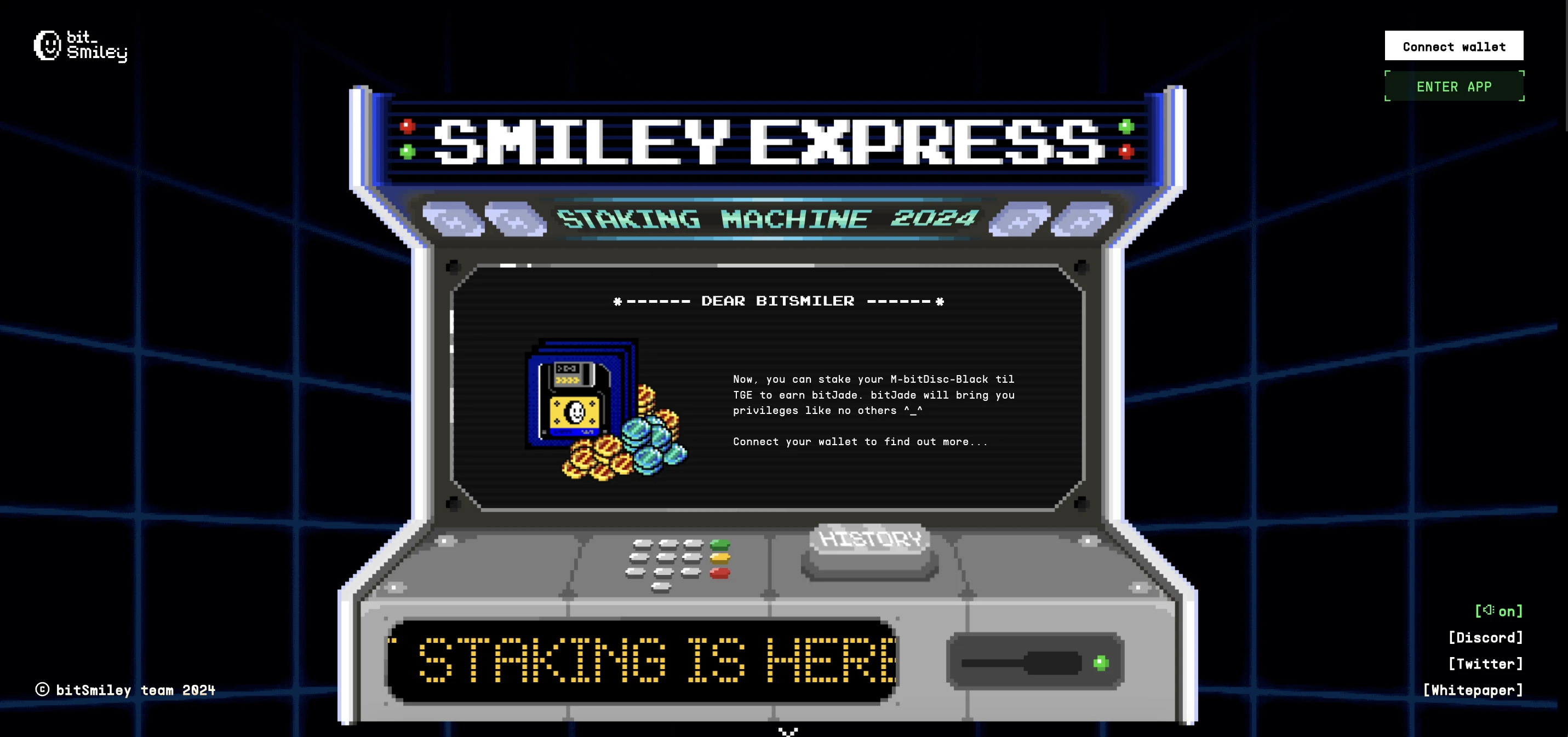
BitSmiley official website interface
It is understood that bitUSD is committed to solving the most critical and core proposition in the BTC ecosystem - asset interest and value circulation. At present, the number of on-chain currency holding addresses exceeds 20,000 (as of writing, the number of addresses is 21,575), TVL exceeds 30 million US dollars, and there are more than 40 ecological cooperation projects. In terms of financing scale, data performance, ecological cooperation, etc., it is in an undisputed leading position in the BTC ecosystem.
Specifically, the advantages and details of bitSmiley and bitUSD include the following aspects:
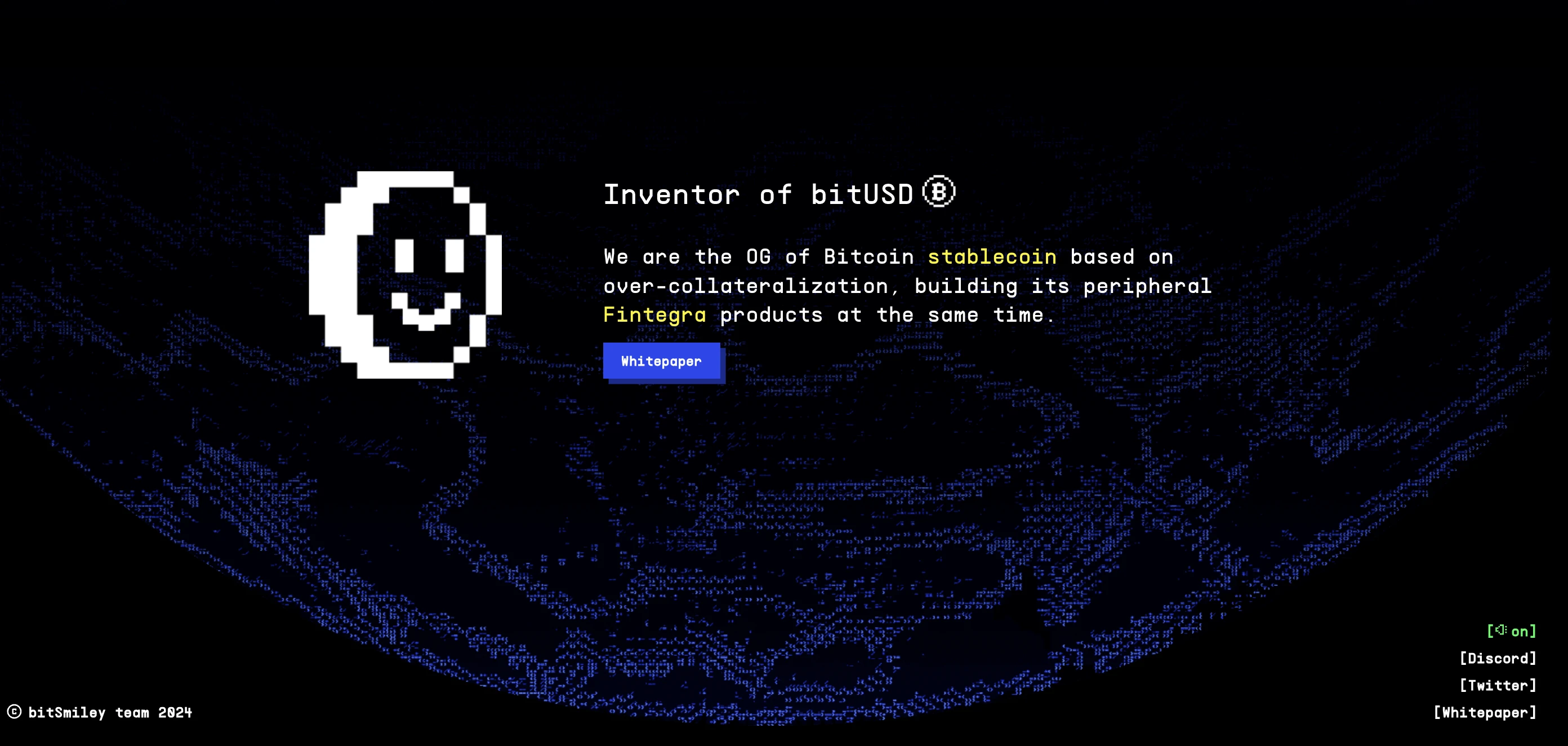
bitSmiley — creator of bitUSD
1. bitUSD: A native over-collateralized stablecoin in the BTC ecosystem
Before the emergence of bitSmiley, the unified settlement currencies of the BTC ecosystem were BTC and SATS, which were greatly affected by market fluctuations. However, after bitSmiley launched bitUSD, this situation has been greatly improved.
According to the official website information and official materials , bitSmiley built the BTC ecological DeFi protocol standard - bitRC-20 protocol based on the inscription BRC 20 protocol standard. On this basis, it created the BTC native over-collateralized stablecoin bitUSD. It is worth mentioning that bitRC-20 can be regarded as an extension of BRC 20, so it is compatible with Brc-20, and in order to meet the needs of stablecoin minting and destruction, it supports minting and destruction operations. Users can over-collateralize BTC to exchange bitUSD. Each bitUSD token in circulation has a corresponding over-collateral as an asset support, and all bitUSD transactions are open and transparent on the Bitcoin blockchain.
The overall minting logic is: 1) Users over-collateralize BTC on the Bitcoin mainnet; 2) The oracle transmits the corresponding information to bitSmileyDAO, waiting for consensus verification; 3) After the consensus verification is completed, bitSmileyDAO will pass the information of Mint bitUSD to the Bitcoin mainnet validator, and finally complete the minting of bitUSD. Its redemption logic is the opposite, that is, after the user redeems the collateral, the corresponding bitUSD will also be destroyed.
Based on the above information, we can know that bitUSD is similar to the over-collateralized stablecoins in the Ethereum ecosystem, and also has the value of value storage, medium of exchange, pricing unit, and deferred payment standard.
In terms of application scenarios, several BTC ecosystem lending projects, including ENZO Finance, Avalon, and PanterFi, have opened support for bitUSD (as collateral or lending bitUSD); at the same time, bitUSD can also participate in the new listings on multiple Launchpad platforms, including Merlin Starter, Pumpad, and BRC Starter. In the bitSmiley protocol, bitUSD can also be used to repay debts, such as paying stability fees or loan interest.
As for the liquidation method of bitSmiley, it is to conduct an English auction with the future platform income as debt. The platform will give priority to repaying creditors after deducting the basic operating expenses. This method is superior to the traditional token inflation repayment method and can avoid the disguised dilution of the interests of token holders.
Based on the core stablecoin, bitsmiley can also expand further to create DeFi products that conform to the BTC technical route, based on peer-to-peer lending supported by its own stablecoin, and superimposed with advanced derivatives such as insurance and CDS, giving BTCFi new gameplay.
After the emergence of bitUSD, users can directly use it as a stablecoin for application currencies within the BTC ecosystem. Subsequent products that users can participate in include the bitSmiley ecosystems native trustless lending protocol bitLending and derivatives protocol bitInsurance, Bitcoins native AMM bitCow, and bitUSD holders consensus governance organization bitSmileyDAO (holders can participate in decentralized governance, including adjusting key protocol parameters such as collateral type and LTV ratio, as well as emergency closure when the protocol is attacked uncontrollably).
In addition, bitSmileys product design uses retro pixel elements, and its official LOGO is also a pixel smiley face, which is not only highly recognizable, but also coincides with the Meme craze that is popular in this cycle. Based on this, the project community and the crypto market have also produced a lot of related secondary creations, the content is very contagious and has a dissemination effect, and has a certain potential to break the circle.

bitSmiley related Meme creation
2. Ecological cooperation map
As a BTC ecological stablecoin protocol, BitSmiley has now reached various levels of cooperation with more than 40 high-quality project parties, including integration.
Among them, the more well-known projects include BitLayer, Merlin Chain, BEVM, Bob, B² Network, Nubit and other well-known BTC L2 networks; also include oracle projects such as Pyth Network, Apro Oracle; also include ZetaChain and other L1 networks, and BTC ecological star project Babylon .
It is worth mentioning that as the first truly launched Bitcoin ecosystem excess stablecoin project, bitUSD has avoided a series of adverse events such as depegging and liquidation during the more than half a year since its launch, highlighting bitSmiley’s strong competitive advantage compared to other competing products.
At the same time, the integration with ZetaChain will help bitUSD expand liquidity to any blockchain network in the future and increase the scale of liquidity, which also makes it the first project that can use the BTC L1 network to mint excess stablecoins for collateral. According to the official cooperation document information , the specific technical implementation details are: ZetaChain and bitSmiley introduced a new protocol layer built on Tapscript in the Bitcoin Taproot upgrade, which allows users to deposit native BTC and mint bitUSD stablecoins with one click; developers can unlock BTC liquidity directly in DeFi through universal applications on ZetaChain. This innovation breaks the 80-byte limit in previous cross-chain transactions based on OP_RETURN, and brings new upgrades to ZetaClient, which can not only use inscriptions to witness data and increase byte size, but also map the hexadecimal address between the users BTC wallet and EVM wallet to achieve a smooth user experience with one-click operation.
The integration with Babylon will expand bitUSD’s collateral categories to various BTC LST assets. It is expected that it will take over a larger portion of its TVL in the future, achieving a win-win situation for the ecosystem.
In addition, DeFi projects, GameFi projects, BTC ecosystem native wallets, and AI projects are also among bitSmileys partners, which shows the richness of its ecological landscape.
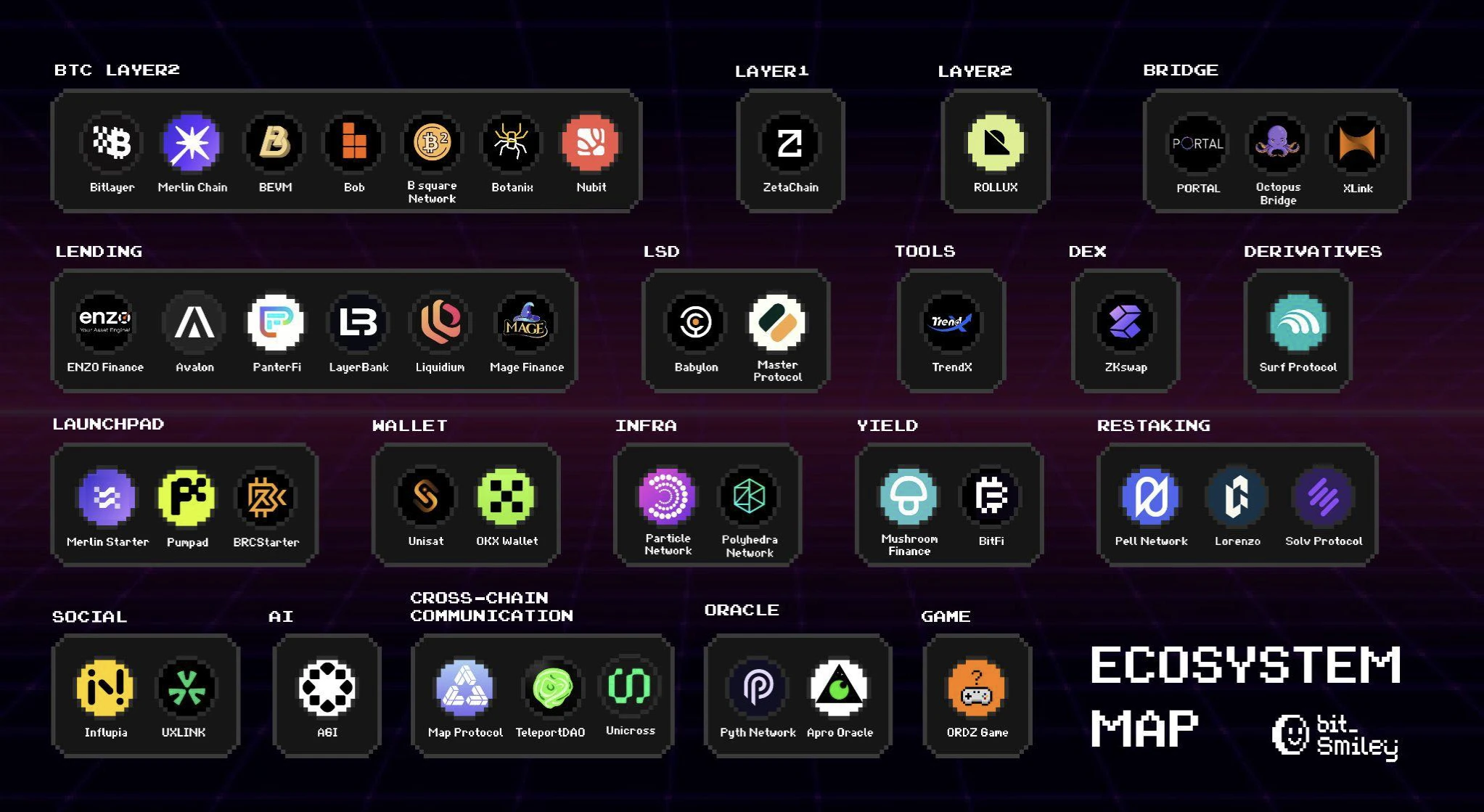
bitSmiley Ecosystem
3. Project past achievements
It is worth noting that before the recently announced second round of financing of US$10 million, bitSmiley had completed its first round of token financing in January this year. The specific amount is unknown. It was led by OKX Ventures and ABCDE, and many angel investors from institutions and organizations such as CMS Holdings, Foresight Ventures, LK Venture, Silvermine Capital, Waterdrip Capital, Blockchain Founders Fund, ArkStream Capital, 7 UpDAO, CGV FoF, Momentum Capital, Candaq Funtech, Comma 3 Ventures and Delphi Digital participated in the investment.
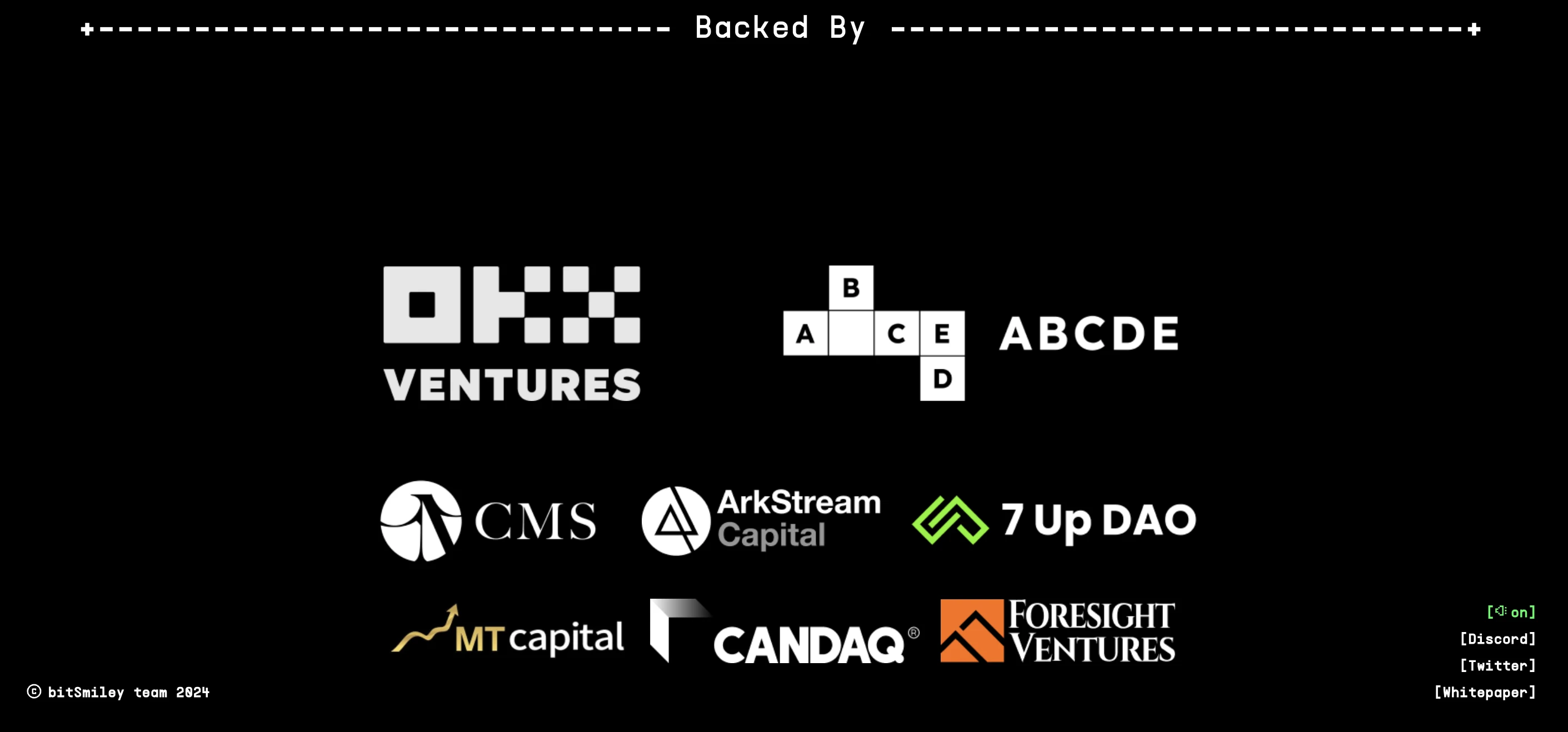
Overview of bitSmiley’s first round of investors
Not only that, bitSmileys previous bitDisc-Black series of inscription NFTs had attracted more than 40,000 addresses to participate in the minting ; the trading volume on OKX NFT Marketplace exceeded 20 BTC in 5 hours, and the floor price was as high as 0.036 BTC (about 2,000+ US dollars), becoming one of the top projects in the BTC ecosystem with a strong wealth-creating effect.
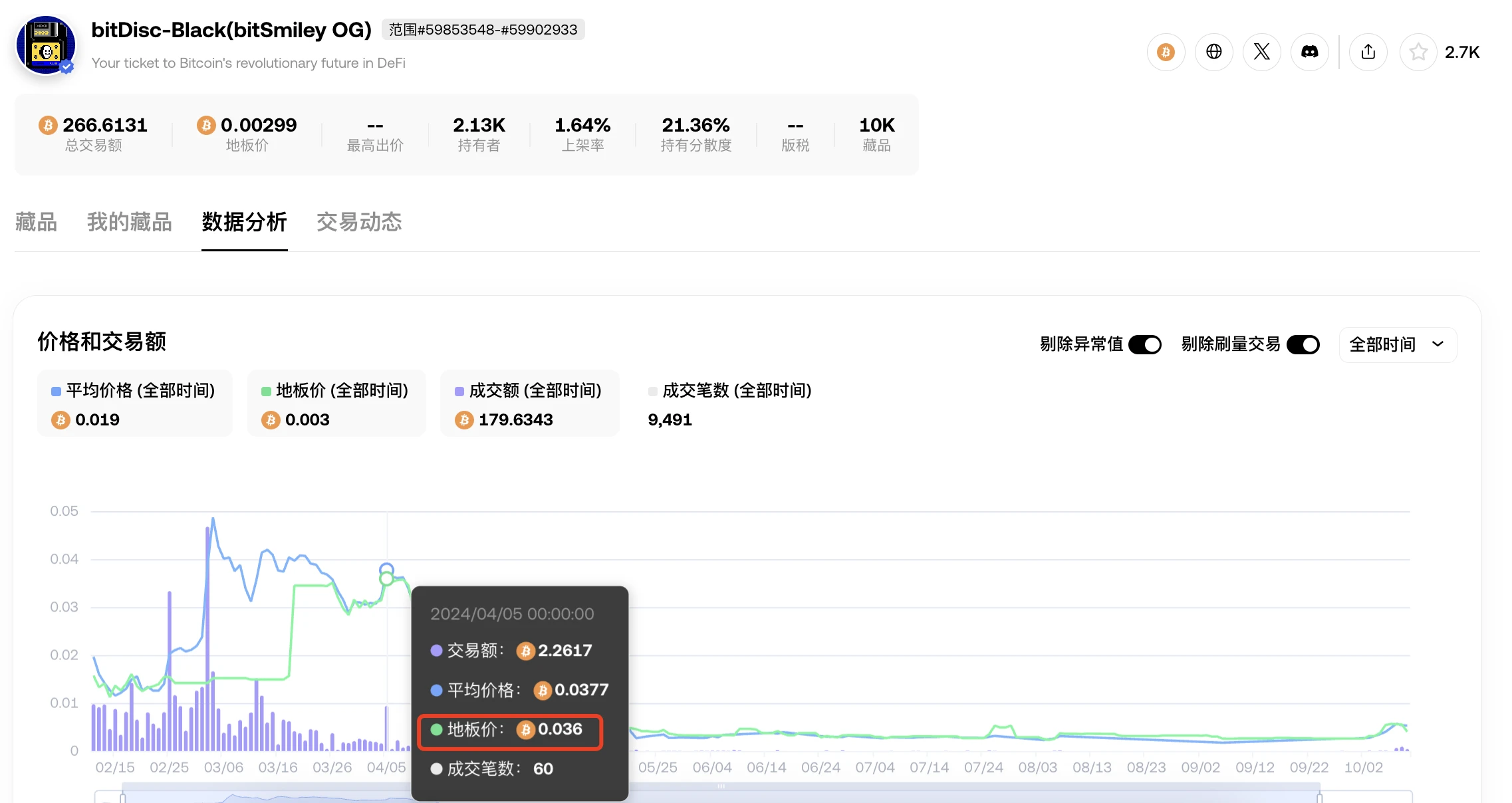
OKX NFT Trading Market Information
It is worth mentioning that the thresholds for a series of airdrop activities of bitSmiley before were quite high. For example, the test network was a targeted invitation system, and the test coin airdrop was only for bitDisc-Black (commonly known as black card) holders or active users of community activities who had undergone multiple verifications. The participation threshold of its main network points activity was also 0.1 BTC, which was also the minimum collateral amount for opening a depository to cast bitUSD. As a result, bitSmiley also gathered a group of active builders of the BTC ecosystem and loyal community users, laying a solid foundation for subsequent development.
4. Future development plan
According to previous financing news , bitSmileys goal is to provide users with a safer and more transparent on-chain DeFi experience in the BTC ecosystem by combining over-collateralization and native BTC loan mechanisms and providing robust liquidity support. The seamless cross-chain transaction capabilities it is building are expected to open up the ceiling of the BTCFi track and further expand the scale of the BTC ecosystem market.
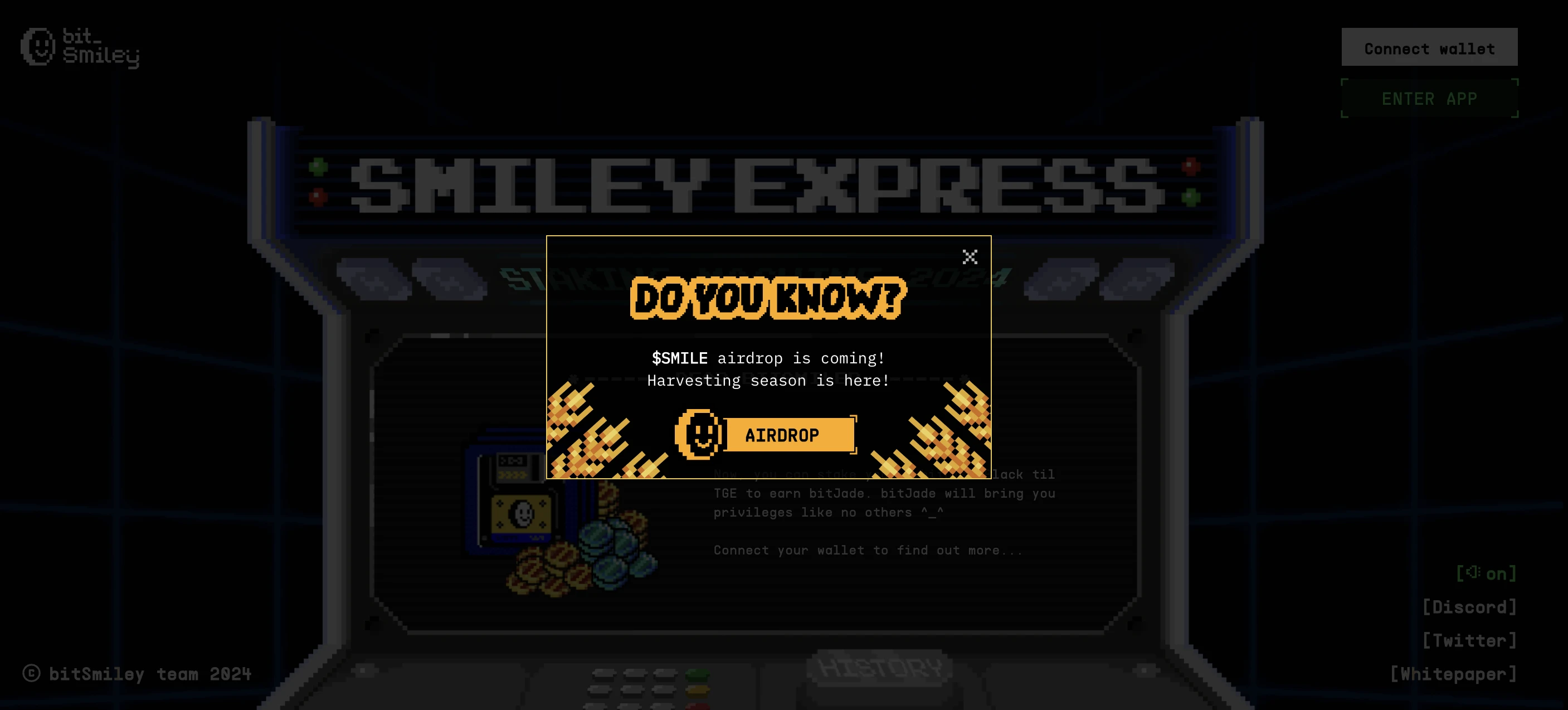
bitSmiley official website interface
According to its official announcement , bitSmiley TGE will also be added to the schedule soon. It is reported that the total supply of its token SMILE is 210,000,000, with different utilities such as governance, participation in surplus auctions, stablecoin fee discounts, priority liquidation, etc. Among them, 3% of the total supply of tokens has been locked as bitDisc-Black staking rewards, and rewards will be distributed according to the number of bitJade held by users. Its official website is now open for staking reward inquiries.
It is worth noting that, as mentioned at the beginning of the article, SMILE tokens will soon be launched on Bybit Launchpad and Gate Startup Prime for IEO. The former has launched 35 IEOs this year, with an average high yield of 20 times. Combined with the data of the bitSmiley project, the high yield is expected to reach 15-25 times, with an average yield of 10 times; the latter is a fist product. Among the 279 Start Up projects so far this year, there are only 6 Prime projects, accounting for about 2.15%. At the same time, SMILE will also be the Prime launch project that Gate will open again after a lapse of 5 months, which shows the strength of bitSmiley and the importance of the exchange. It can also be seen that the BTCFi track is in full swing and bitSmiley is just in time.
As bitSmiley co-founder J Yee previously stated, bitSmiley will further optimize the BTCFi infrastructure construction, expand the team size, and accelerate the launch of innovative functions, striving to promote the wider application of BTC in the DeFi field.
Conclusion: bitUSD may become the key fulcrum to leverage the BTCFi bull market
According to data from the DefiLlama website , MakerDAO, the largest over-collateralized stablecoin issuer in the Ethereum ecosystem, has a total TVL of $4.44 billion and over 500,000 on-chain currency holding addresses. In comparison, bitSmiely, which has been firmly in the leading position of the BTC ecosystem over-collateralized stablecoin track, still has great potential for subsequent development. With the support of bitUSD, the value circulation system of the BTCFi track has become more mature, and coupled with the existing favorable conditions in the market, it may become the key fulcrum for detonating the BTC ecosystem bull market.
After all, compared to MakerDAO, which uses Ethereum as collateral, bitSmileys chosen collateral is digital gold BTC, which has a higher market value, better liquidity, and greater demand. There is no doubt that the gradual expansion of the BTCFi track will also drive the rapid growth of bitSmiley TVL, and its token SMILE is also expected to follow the footsteps of MakerDAOs token MKR and create a wealth miracle that is no less than MKRs crazy increase of up to 50 times when it goes online.
There are always people saying that if they could go back in time, they would definitely seize the opportunity to make money from Ethereum, UNI, MKR and other tokens; and now, bitSmiley’s bitUSD has emerged as the “leader of native over-collateralized stablecoins in the BTCFi track”. Whether this opportunity can be seized still depends on the subjective choice of every market user.










